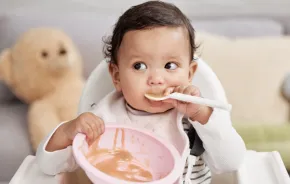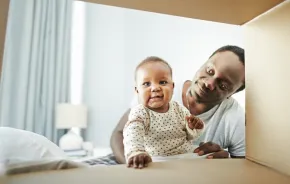The toddlers, some of them not yet 2, seem oblivious to the task at hand. Their moms try to settle them down, but they are more interested in chasing each other around the room than watching their teacher bring out a collection of straw hats with brightly colored headbands.
She is teaching them to say “put on your hat” — a challenge for those just learning to talk. The real surprise, however, is that this hourlong class for these American toddlers is being taught exclusively in Chinese.
 The class in Mandarin is one of many offered through Sponge, a 3-year-old organization dedicated to the premise that small children’s brains are particularly well suited to learn languages; that, in fact, they soak it up like little sponges.
The class in Mandarin is one of many offered through Sponge, a 3-year-old organization dedicated to the premise that small children’s brains are particularly well suited to learn languages; that, in fact, they soak it up like little sponges.
Yi Ning Chen, who came to this country when she was 9, conducts the class with that in mind. She play music, games and counts out snacks, all in Mandarin. Even when the tots don’t seem to be paying attention, they’re getting it, Chen says.
“Kids are really smart. They can pick up different languages, and it makes them better able to learn a language when they’re older,” she says.
Taryn Zier began taking her children to Spanish classes at Sponge when they were both a few months old. “When they started to speak English words, both kids started speaking Spanish words as well,” she says. “It’s really amazing what they can pick up. Their brains are really primed for learning.”
Seattle mom Jackie Friedman Mighdoll founded Sponge because she couldn’t find similar language programs for her son four years ago. “Language had played such an important role for me; I wanted that for him, too,” says Mighdoll, who taught herself Japanese when she lived in Japan with a college friend’s family.
Today, more than 400 families take classes in Japanese, Mandarin, Spanish and French at Sponge. All the teachers are native speakers. “They really understand that they have to make it fun and interactive and motivate them to use the language,” Mighdoll says. “They share that real love of their own language and culture, and a love of children.”
Interest in early language programs is growing, and the push is coming from parents, according to Michele Anciaux-Aoki, who was recently appointed to the new position of world languages supervisor for the Office of Superintendent of Public Instruction for Washington state. Her job is to be the representative for world languages as they are taught in the state’s 295 school districts.
“We live in an interdependent world,” she says. “Having 21st-century skills means having the skills to work with people around the world.”
Research shows that babies are born with the ability to distinguish sounds and that small children have a special capacity to learn languages, she says.
“It’s sad that, for so many years, we pressured immigrant families to speak English at home,” she says. “These kids should learn English, of course. But we are impoverishing kids when we don’t expose them to a language in the way it would be spoken.”
Schools immerse kids in languages
Language immersion was the catalyst for the creation of the Seattle school district’s John Stanford International School in the fall of 2000. Students spend half of each school day learning math and science in Spanish or Japanese.
Karen Kodama, former principal at John Stanford who is now international education administrator for Seattle Public Schools, says parents had concerns at first. “They were thinking, ‘Oh my gosh, this is so different,’” she recalls. “I told them, ‘You need to come in and see it in action.’”
Kodama acknowledges that the students experience some frustration during the first week or two. “But it’s amazing how quickly they pick it up,” she says. “These kids tend to be able to replicate sounds; they hear it better than older kids or adults. So they sound more like native speakers.”
Beyond learning another language and culture, students at John Stanford have performed well academically. “As soon as they hit fourth grade, the WASL scores jumped 20 points and they continued to stay high,” she says. “Research has shown that when kids learn a second language, they outscore their monolingual counterparts.”
Since the John Stanford school opened, the Seattle school district has added two more international schools: Hamilton International Middle School and Beacon Hill International School. Kodama’s goal is to create nine more language-immersion schools in the three geographic areas of the Seattle school district.
Since John Stanford has one of the longest waiting lists in the district, the new language schools should be popular with parents who expose their toddlers to additional languages. But until language programs are widely available in elementary schools, how do parents keep it going?
Anciaux-Aoki says it doesn’t necessarily involve finding more classes. “A lot of it is creating an environment which values speaking another language and learning about another culture,” she says. That can involve everything from playing with American Girl dolls of other cultures to going to a restaurant and using the language to order a meal.
Exposure at a young age also opens children’s eyes to learning about other cultures, Mighdoll says. “Playing in another language is natural to them. They embrace it and it can grow with them. It keeps their openness to being part of the global community alive in them.”
Maple Valley mom Lisa Barker has seen this phenomenon with her 3-year-old daughter Evyn, who has been learning Spanish and Japanese at Sponge for the last year. Hiking in the Olympics, her family noticed an Asian family hiking toward them. Evyn listened to their conversation and announced, “They’re speaking Japanese; they’re from Japan.”
Barker admits that Evyn also likes to show off her language skills a bit. When it’s time to sing the clean-up song at her preschool, she sings it in Japanese.
Elaine Bowers lives in Magnolia with her husband and teenage twin daughters.











